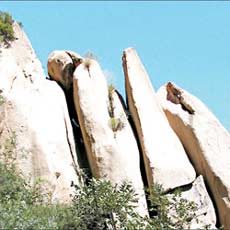
Mountain hiking in the forest parks around Beijing has become a very popular activity among tourists for a weekend trip.
Baiwang Mountain and Fenghuang Mountain are two such sites in the northwest suburbs of Beijing. Both mountains are covered with thick forest and shrubs. Despite their natural forest, rocks, mountain roads and some shabby temples, the two mountains do not attract as many visitors as the Fragrant Hills (Xiangshan). So visitors here can always have a chance to enjoy a relatively quiet hiking trip.
Baiwang Mountain is the closest forest park to Beijing, located about three kilometers northwest of the Summer Palace, It is particularly popular among older travelers thanks to the low average (200-meters) altitude.
The forestry park covers an area of roughly 133 hectares with the Beijing-Miyun Diversion Canal crossing through it. The dominant peak is 210 meters above the sea level.
The mountain was known as "Wang'er Mountain" among old Beijing locals. Tradition had it that in the Northern Song Dynasty (960-1127), Yang Liulang (the sixth son of Yang Family) engaged in a fierce battle with the army of Liao. She Taijun, his mother, witnessed the battle and cheered for him on the mountain, thus came the name. Now, a statue of Yang's mother She stands on the north side of the mountain.
There are many steles with themes of protecting nature and promoting a green environment inside the gate of the park. Some pavilions and corridors have been built in the Stele Forest.
This forest of steles collects inscriptions, poems, verses, paintings and calligraphy on "green propaganda" by country leaders, celebrities as well as painters and calligraphy artists.
The mountain park has many places for ascending the heights and for viewing scenery, such as the Building for Overlooking Beijing, the Maple-Leave Picking Pavilion, the Looking Back Pavilion and the Pavilion of Friendship. Meanwhile, the park provides scrambling, and orienteering so that visitors can take plenty of exercise.
Two hours are enough to complete the mountain trip. After you get to the top, it is better to choose a different way to descend, so as to enjoy some different views.
Entrance: 6 yuan.
Visitors to the mountain are scarce, so there are enough parking sites at the right side of the main gate of the park.
To get there: Take bus route 933 at Xizhimen or 330 at the north gate of the Summer Palace.
Tel: 86-10-62884508 (Chinese only).
Fenghuang Mountain is a challenging site, even for youngsters. But it is worth trying a trek along the tree-covered zigzagging natural mountain lanes.
The park is approximately 33 kilometers away in a straight-line northwest from Tiananmen Square. It is about 25 kilometers northwest of the Baiwang Mountain.
The best time to visit the mountain is from April to October.
The mountain covers 15 square kilometers and is divided into three travel sections: the South Travel Route, Central Travel Route and the North Travel Route.
If you want to tour all the three routes, you will have to spend two days there: one day for the south and central parts and one day for the north part.
Inside the main gate are two small temples: Guandi Temple (The God of War Temple) and Longquan Temple (Dragon Spring Temple).
Temples dedicated to the God of War were once one ubiquitous in Beijing, celebrating the manly and public virtues of the historical figure Guan Yu (162-220 AD). Guan was especially venerated in ancient China for his bravery, loyalty and legendary martial skills known throughout the country.
The Dragon Spring Temple has a history of more than 1,000 years, dating from the Liao Dynasty (926-1125). There is a legend that at the bottom of the pool there is a golden teapot large enough to slake the thirst of nine people.
Other features of the temple compound include two large Maidenhair trees that still bear ginkgo fruit despite being there for a millennium, and a small pagoda containing the remains of a Buddhist master surnamed Wei. A large pair of stone shoes sits at the base of the reliquary.
The main gate where the two temples are situated belongs to the Central Travel Route. From the backyard of the temples to the south is the South Travel Route; to the North is the central and north part.
Grotesque rocks, mountain peaks, pavilions and towers made of huge rocks are the main features of all the routes.
The south and the central parts need about five hours and the northern part needs another five hours for an ascent and descent trip.
At the foot of the mountain, many fruit-picking fields are open for visitors. Jujube, apple, pear and pumpkin can be found in the fields. Local farmers also put piles of these fruits and pumpkins along both sides of the road to the mountain gate. The produce is cheaper than you can buy from downtown shops.
Entrance: 15 yuan.
Parking fee: Five yuan for 5-seat sedans and eight yuan for large bus a day.
To get there: take bus route 346 at the Summer Palace.
Tel: 86-10-62459492 (Chinese only).
(China Daily September 23, 2005)
|

